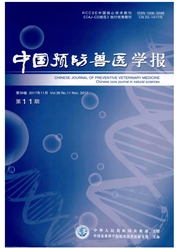

 中文摘要:
中文摘要:
为了解内蒙古地区蓝舌病(BT)流行情况,本研究于2013年对内蒙古存在疑似BT病例地区进行流行病学调查,收集了内蒙古6个盟市不同种类动物的抗凝血及其对应血清样品212份,采用竞争ELISA及套式RT-PCR方法对样品进行检测.竞争ELISA检测结果显示212份血清样品中有63份为BT阳性样品,13份为BT弱阳性,总阳性率为35.85%(76/212).套式RT-PCR检测结果显示212份血液样品中有61份为BT阳性样品,总阳性率为28.77%(61/212),其中绵羊感染率为21.25%(17/80)、绒山羊感染率为35.35%(41/116)、牛感染率为18.75%(3/16).不同的饲养方式对动物感染BT也有影响,其中圈养感染率为16.67%(1/6),散养感染率为29.13%(60/206).本研究结果表明,内蒙古地区BT流行范围比较广泛,因此有必要加强该病的检测及预防.
 英文摘要:
英文摘要:
To investigate the prevalence of bluetongue disease (BT) in Inner Mongolia,a total of 212 blood samples were collected from ruminant livestock in different regions of Inner Mongolia in 2013,and subjected to detections by competitive ELISA (C-ELISA) and nested RT-PCR methods.The results showed that the BT positive rates of samples were 35.85% (76/212) detected by C-ELISA and 28.77% (61/212) by RT-PCR.In addition,the BT virus (BTV) infection rate was 21.25% (17/80) in sheep,35.35% (41/116) in cashmere goats,and 18.75% (3/16) in bovine.However,different feeding methods also had an impact on BTV infection.The BTV positive rates were 16.67% (1/6) and 29.13% (60/206) for livestock raising in pen-stabling and non-pen stabling,respectively.These data demonstrated that the BTV was widely prevalence in Inner Mongolia,therefore it is necessary to strengthen the detection and prevention of this disease.
 同期刊论文项目
同期刊论文项目
 同项目期刊论文
同项目期刊论文
 期刊信息
期刊信息
